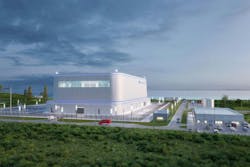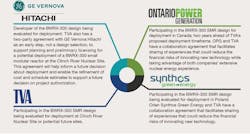TVA Files First SMR Permit for GE Vernova Reactor, Paving Path to Nuclear-Powered Data Centers
In May 2025 the Tennessee Valley Authority became the first power utility in the United States to submit a construction permit application to the Nuclear Regulatory Commission (NRC) for a small modular reactor (SMR).
While we have been covering the large number of announcements over the last year or so about letters of intent and other forms of agreements between data center operators and the bevy of SMR developers that have entered the market, this permit application from the TVA for the first GE Vernova Hitachi BWRX-300 is one of the first concrete developments between companies that have a track record between power generation and utility power.
GE Vernova On the Move
GE Vernova has been making significant inroads with data center operators for their non-nuclear operations recently. In February we reportrd on the joint efforts of the company with Chevron and Engine No. 1 to collocate natural gas power plants with data centers.
Earlier this month, GE Vernova announced the signing of a strategic framework with AWS focused on scaling AWS data centers not only with power generation but also turnkey substations for power distribution, with worldwide project management and construction support as well as a collaboration on futher development of renewable energy sources.
GE also has a significant presence and history in the development and deployment of nuclear power, with their Vallecitos BWR (boiling water reactor), an ancestor of the BWRX-300, delivering power to the grid starting in 1957. It was the first privately owned and operated nuclear power plant to do so. This was the first of 67 reactors that GE has licensed in 10 countries.
TVA Knows Nuclear and Data Centers
The TVA is also no newcomer to nuclear power, with their first nuclear power station beginning commercial operation in August 1974. The utility operates 7 reactors at 3 generating stations with capacity that exceeds 8.2 GW.
TVA is experienced in working with the data center market, and currently has contracts to provide power, both from nuclear and renewable source to Google data centers in Clarksville, TN and Hollywood, AL, as well as the somewhat contentious xAI artificial intelligence data center in Memphis, TN.
The TVA has also been aggressively pursuing advanced reactor development and got the first early site permit for SMRs from the NRC for its Clinch River site in 2019.
TVA's initiative is part of a broader collaboration involving Ontario Power Generation, Synthos Green Energy, and GE Vernova Hitachi Nuclear Energy. This partnership aims to standardize the BWRX-300 design and facilitate its deployment across North America and Europe.
The Clinch River site is also near Oak Ridge, the historic site of the Manhattan Project, as well as the Oak Ridge National Laboratory, a TVA partner in the development of next-generation nuclear power. ORNL Director Thomas Zacharia said:
We are combining our world-leading research capabilities and TVA’s operating expertise to accelerate the next generation of cost-effective nuclear power, Nuclear has long been a key component of the U.S. energy portfolio, and growing demand for emission-free electricity requires that we innovate to ensure safe, affordable and efficient nuclear power for generations to come.
Last month, the TVA applied to the Department of Energy for $800 million in support to advance the Clinch River Project, with a goal of building the reactor, establishing a domestic supply chain, and to support future nationwide deployment of the technology.
While this project progresses, the TVA is also continuing to evaluate both light-water and non-light-water cooled reactors. Light-water, Gen III+ reactor technology is considered most ready for near-term deployment.
And as part of the site preparation, the company has issued the Final Supplemental Environmental Impact Statement that address potential environmental effects of the construction of one BWRX-300 at Clinch River.
What Is the BWRX-300?
The BWRX-300 is a 300 MW boiling water reactor SMR design that builds upon the design and operational experience of GE's previous reactors. Key features include:
Modular Construction: The reactor is designed for modular construction, enabling faster build times and scalability. This approach allows for components to be manufactured off-site and assembled on-site, reducing construction timelines and costs. It is also a key feature of the SMR model which looks at modular designs that can be scaled by increasing the number of units.
Simplified Design: By reducing the number of components and systems, the BWRX-300 aims to lower construction and operational costs. The reactor's design is very much a “safety-first” approach, which minimizes the need for extensive safety-related systems, contributing to its economic efficiency.
Passive Safety Systems: The reactor utilizes natural circulation for cooling, eliminating the need for active pumping systems. This design allows the reactor to maintain safe conditions without external power or operator intervention, even in extreme scenarios. The design is expected to be able to passively cool for seven days without any external support.
With the approval of funding, the TVA has projected the following timeline:
- August 2025 – Begin next phase of project and work within the authorized budget.
- January 2026 - Begin early site preparation.
- November 2026 - Begin foundational work/reactor excavation.
- October 2028 – Begin nuclear construction.
- December 2032 – Begin commercial operation.
Don Moul, TVA President and CEO, said of the project:
Nuclear is a vital part of our energy security and our economic future. At Clinch River we’re advancing nuclear and the foundations of the American nuclear supply chain to support America’s future as a leader in AI and industrial technologies.
A Signal Moment for Power Optionality in AI Infrastructure
TVA’s Clinch River filing marks more than a procedural milestone. It represents a maturing alignment between nuclear development and digital infrastructure planning — not in theory or marketing language, but in capital-intensive, regulatory-actionable progress.
For the data center industry, especially in an era shaped by AI demand curves, this signals a pivot point in how future workloads will be powered at scale.
From Conceptual Hype to Constructive Motion
Over the past 18 months, small modular reactors have moved from speculative talking point to serious strategic pathway in boardrooms evaluating power procurement beyond five-year horizons.
Data center operators, utilities, and capital partners are beginning to coordinate efforts with a longer-term view of grid capacity, resilience, and carbon accountability.
What distinguishes the TVA-GE Vernova BWRX-300 announcement is its institutional credibility. TVA is both a nuclear operator and a data center power supplier. GE Vernova, through its AWS partnership and growing presence in energy-adjacent infrastructure delivery, is executing across domains.
The commitment here is operational, not aspirational — backed by timelines, permits, and intergovernmental coordination.
Implications for Hyperscale and Beyond
For hyperscale developers, this filing expands the frontier of viable site strategies. SMRs are not a near-term replacement for grid interconnection, but their future role as baseload complements to intermittent renewables is being formally modeled into development roadmaps.
In regions with strained transmission capacity or contested fossil fuel reliance, modular nuclear becomes a long-cycle hedge — and potentially, a differentiator in ESG reporting, carbon accounting, and energy procurement.
TVA’s leadership, in concert with partners across the U.S. and Canada, also moves the conversation closer to standardization.
That standardization — in design, safety, and siting — is a necessary precondition for the kind of repeatable, scalable deployments that hyperscalers depend on in every other aspect of their operations.
The Nuclear Future, Under Construction
There remains a wide gulf between a single reactor application and a nuclear-powered data center campus. But TVA’s move narrows that gulf. By situating nuclear development alongside AI infrastructure growth — and doing so through regulatory pathways rather than speculative announcements — TVA and GE Vernova have reframed what actionable progress looks like in energy innovation.
For the data center sector, the signal is clear: modular nuclear is a measurably less distant promise. It’s a permitted project, backed by a utility with grid authority, serving cloud clients already onsite.
In a power-constrained decade, that makes Clinch River a development to watch — not just for its reactor, but for the infrastructure model it may help define.
At Data Center Frontier, we talk the industry talk and walk the industry walk. In that spirit, DCF Staff members may occasionally use AI tools to assist with content. Elements of this article were created with help from OpenAI's GPT4.
Keep pace with the fast-moving world of data centers and cloud computing by connecting with Data Center Frontier on LinkedIn, following us on X/Twitter and Facebook, as well as on BlueSky, and signing up for our weekly newsletters using the form below.
About the Author

David Chernicoff
Matt Vincent
A B2B technology journalist and editor with more than two decades of experience, Matt Vincent is Editor in Chief of Data Center Frontier.



